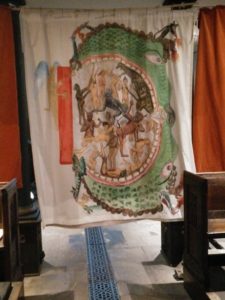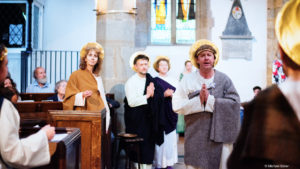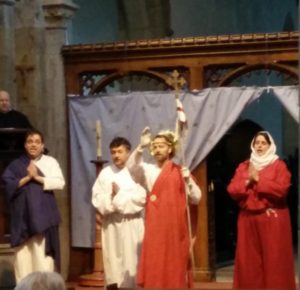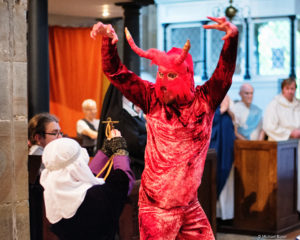[Dr. Mark Chambers:]
In December of 2016, I interviewed Ros Barnes, chief Wardrobe Mistress for the Summer 2016 St. Oswald’s play performances of the Anglo-Saxon Harrowing of Hell and Lawrence of Durham’s Peregrini – both feature productions in Durham’s Theatrum Mundi play festival last summer. In addition to creating the fabulous costumes for the St. Oswald’s productions, Ros also assisted with the design and tailoring of costumes for the massive Renaissance spectacle which took place on Palace Green, ‘The Sacred and the Profane’.*
Here is transcript from part of our interview:
‘Ros, what was your inspiration for the costumes used in The Harrowing of Hell , and particuarly those outrageous devils?’
‘Both the plays that we performed this year are very early, so I was looking for Anglo-Saxon, and Early Norman evidence. John (McKinnell) pointed me in the direction of the Junius manuscript. Interestingly devils were often depicted as more-or-less human, which dramatically wouldn’t have had a big impact, so I looked at later visuals, and eventually settled on the hell-mouth from the Winchester psalter, which, in a slightly simplified version, I also used for the back drop. Two of the devil -masks existed from a previous production, so were re-used.’

‘Hellmouth’ screen for the Anglo-Saxon Harrowing of Hell, Durham Medieval Theatre Company performances in St. Oswald’s Church, July 2016. Photo credit: Ros Barnes
‘Costumes for the Peregrini play seemed to resemble some kind of painting. Where did you take your inspiration for costumes for the pilgrims, Jesus and the apostles?‘
‘Early pictures of Apostles give you a “matching Set”, with individuals usually carrying their identifying symbols. Such is life, that costumes that would have filled the bill, made for previous productions, were no longer available (It was some 16 years ago!). So more “big-nightie” basic gowns were required, with added wrap-around cloaks secured with a brooch and names on haloes as a means of identification. Real linen and wool were beyond our budget, so I put out a call for unwanted curtains and sheets, and then set to with the scissors, using a pattern that I adapted from an early nun’s habit. This pattern makes economical use of a length of fabric, producing little waste, which one assumes is how things would have been done when cloth was hand woven. (Since I was to be out of the country mid-April to Mid June, it was necessary to get on with these, even before they were all cast, so the one-size –for –all method really had to work here!).

Peter (Geoff McIntyre) announces the truth of the Resurrection. Photo credit: Michael Baker.
‘How long did it take you to make all of these? And how many people were involved?‘
For me, the making – though it takes time – is not problematic. Yes, I may burn the midnight oil more than I should, but that is nothing compared to the dithering that goes on when I’m fixing on a design. As mentioned above, I had to get on with the job before going away. Fortunately I was able to twist a few arms, so fellow members of the Embroiderers’ Guild helped put some costumes together, and Norma Goff, though new to the whole scene, efficiently sewed, plastered and felted to my crazed demands!
It was just as well that the Harrowing of Hell and Peregrini costumes were made in good time, as Barbara (Ravelhofer) found herself short of costume makers, so Norma and I set to and sewed skeleton costumes and made skeleton masks the week before the performance!’

Skeleton costumes for the Sacred and the Profane performance

Ros Barnes and Norma Goff
‘Did any of the costumes pose a particular challenge? Were there some that caused you trouble?’
Footwear! Most medieval drawings are delightfully vague when it comes to what goes on the feet. Add to this that anything leather and specially made will be expensive and the whole business can become a nightmare. We attempted felted boots, but this was very last minute, which I regret, since they took far longer than I anticipated to dry out!
I should mention fabrics, I suppose. I gave up on being a purist years ago. Whilst Medieval Scholars will probably be looking towards authenticity – i.e fabrics and construction as in Medieval times – we have never had the kind of funding which would enable us to a) purchase only historically correct fabrics, or b) employ sufficient handsewers to put them together. I’m sure there’s a thesis there, if its not already been written, around the whole question of who made the costumes in Medieval times, how long they were in use, and what state they were in by the time they were retired.

Anglo-Saxon Harrowing of Hell, Christ blesses audience. Abraham (Craig Thompson), Adam (Adam Speight), Christ (Mark Chambers), Eve (Helen Barber). Photo: Mike Huxtable
So: I’m not averse to using hooks and eyes and cords and ribbons rather than zips, but I’m not in the business of handsewing miles and miles of seams. Similarly, I use modern elasticated fabrics (as for the devils in the Harrowing of Hell).
It’s not the costumes per se that pose a challenge, so much as the folk who have to wear them! There are always divas who don’t want to wear it as designed/insist on adding their own “bits”/ don’t look after their costume – losing pieces and/or leaving things scrunched up in a bag on the floor – and this production proved no different in this respect.’
‘Do you have a favourite from your creations?‘
‘It’s got be the devils; Why? I suppose because they are the costumes where I can be a bit more creative, where no one can point a finger and say it’s wrong, because there is endless variation in the pictorial evidence.’

Satan (Gasper Jakovac) tries to escape. Photo credit: Michael Baker.

Anglo-Saxon Harrowing of Hell, a devil (Gordon Bond). Photo credit: Michael Baker

First devil (Heather Prestwhich) and Satan, after performance. Photo credit: Michael Baker
‘And I understand you’ve worked with Durham Medieval Theatre Company before. What other productions have you worked on?’
The first Medieval Production that I worked on was the Digby Mary Magdalene, which we performed during the 150th anniversary of Durham University in 1982 when Margot Fonteyn was inaugurated as Chancellor. Since then I have designed and made costumes for:
Balaam and Balaak
The Assumption of the Virgin
The Harrowing of Hell
The Temptation of Christ/the Ascension
The Last Judgement
Mary of Nemmegen
The Resurrection
Doomsday
The Summoning of Everyman
Dame Sirith
– and a re-enactment of the Durham “Boy Bishops” ceremony’.
[Mark:] ‘Wow, that’s certainly an impressive array of medieval productions, Ros! Thanks so much for talking with me today and sharing some of the background of your work, and thanks so much for the brilliant, exemplary costumes. I can’t wait to see your work in future productions!’

Ros making the mask for one of the skeletons
*Ros Barnes was interviewed by Mark Chambers on behalf of Durham’s Records of Early English Drama North-East Project, co-sponsers of the 2016 Theatrum Mundi festival.
